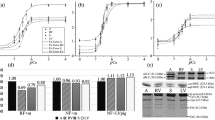Summary
The dependence of the arrangement of fibrillar actin in cultured endothelial cells on metabolic conditions was investigated with cellular elements derived from the heart of Xenopus laevis tadpoles. Either primary culture or an established cell line (XTH-2) were used in these studies The metabolic stage of the cells was influenced by inhibiting respiration and lactate production. The actin pattern was revealed either by indirect immunofluorescence or by tetramethylrhodaminyl (TRITC)-phalloidin fluorescence. Total block of energy supply causes in all cases a distinct loss of actin fibrils, while inhibition of respiration alone increases the variability of actin organization. In primary XTH cells but not in XTH-2 cells cyanide disintegrates most of the actin fibres during 3 h of treatment. This effect is independent of the inhibition of respiration, since actin gels prepared from skeletal muscle also undergo destruction in the presence of cyanide. It is concluded that the actin fibrils of the primary cells and the established line behave differently to changing metabolic conditions and to application of KCN.
Similar content being viewed by others
References
Bereiter-Hahn J, Vöth M (1983) Metabolic control of shape and structure of mitochondria in situ. Biol Cell 47:309–322
Bereiter-Hahn J, Strohmeier R, Kunzenbacher I, Beck K, Vöth M (1981) Locomotion of Xenopus epidermis cells in primary culture. J Cell Sci 52:289–311
Bershadsky AD, Gelfand VI (1981) ATP-dependent regulation of cytoplasmic microtubule disassembly. Proc Natl Acad Sci USA 78:3610–3613
Bershadsky AF, Gelfand VI (1983) Role of ATP in the regulation of stability of cytoskeletal structures. Cell Biol Int Rep 7:173–187
Bershadsky AD, Gelfand VI, Svitkina TM, Tint IS (1980) Destruction of microfilament bundles in mouse embryo fibroblasts treated with inhibitors of energy metabolism. Exp Cell Res 127:421–429
Brinkley BR, Barham SS, Barranco SC, Fuller GM (1974) Rotenone inhibition of spindle microtubule assembly in mammalian cells. Exp Cell Res 85:41–46
Carley WW, Barak LS, Webb WW (1981) F-actin aggregates in transformed cells. J Cell Biol 90:797–802
Colowick SP, Nagarajan B (1972) Energy sources for tumor growth. In: Pietro AS, Gest H (eds) Horizons of bioenergetics Academic Press New York, London, pp 97–112
Drenckhahn D (1983) Cell motility and cytoplasmic filaments in vascular endothelium. Prog Appl Microcirc 1:53–70
Faulstich H, Trischmann H, Mayer D (1983) Preparation of tetramethylrhodaminyl-phalloidin and uptake of the toxin into shortterm cultured hepatocytes by endocytosis. Exp Cell Res 144:73–82
Götz v. Olenhusen K., Wohlfahrt-Bottermann KE (1979) Evidence for actin transformation during the contraction-relaxation cycle for cytoplasmic actomyosin: cycle blockade by phalloidin injection. Cell Tissue Res 196:455–470
Korohoda W, Shraideh Z, Baranowski Z, Wohlfarth-Bottermann KE (1983) Energy metabolic regulation of oscillatory contraction activity in Physarum polycephalum. Cell Tissue Res 231:675–691
Meisner HM, Sorensen L (1966) Metaphase arrest of Chinese hamster cells with rotenone. Exp Cell Res 42:291
Portzehl H (1951) Muskelkontraktion und Modellkontraktion. Z Naturforsch 6b:355–361
Rose GG, Pomerat CM, Shindler TO, Trunnell JB (1958) A cellophane-strip technique for culturing tissue in multipurpose culture chambers. J Biophys Biochem Cytol 4:761–764
Schlage WK, Bereiter-Hahn J (1983) A microscope perfusion respirometer for continuous respiration measurement of cultured cells during microscopic observation. Microsc Acta 87:19–34
Schlage W, Kuhn C, Bereiter-Hahn J (1981) Established Xenopus tadpole heart endothelium (XTH) cells exhibiting selected properties of primary cells. Eur J Cell Biol 23:21
Vasiliev JM (1982) Spreading and locomotion of tissue cells: factors controlling the distribution of pseudopodia. Phil Trans R Soc Lond B 299:159–167
Weber K, Wehland J, Herzog W (1976a) Grise fulvin interacts with microtubules both in vivo and in vitro. J Mol Biol 102:817–829
Weber K, Rathke PC, Osborn M, Franke WW (1976b) Distribution of actin and tubulin in cells and in glycerinated cell models after treatment with cytochalasin B (CB) Exp Cell Res 102:285–297
Webster RE, Osborn M, Weber K (1978) Visualization of the same PtK2 cytoskeletons by both immunofluorescence and low power electron microscopy. Exp Cell Res 117:47–61
Wehland J, Osborn M, Weber K (1977) Phalloidin-induced actin polymerization in the cytoplasm of culture cells interferes with cell locomotion and growth. Proc Natl Acad Sci USA 74:5613–5617
Wolf K, Quimby MC (1962) Synthetic media. Amphibian culture medium (Wolf and Quimby). Excerpta Medica 16:Nr. 9
Author information
Authors and Affiliations
Rights and permissions
About this article
Cite this article
Bereiter-Hahn, J., Tillmann, U. & Vöth, M. Interaction of metabolic inhibitors with actin fibrils. Cell Tissue Res. 238, 129–134 (1984). https://doi.org/10.1007/BF00215153
Accepted:
Issue Date:
DOI: https://doi.org/10.1007/BF00215153




